#Quantum Computing & Technologies Market Forecast
Link
The Global Quantum Computing & Technologies Market was valued at USD 472 Mn in 2021. The market is projected to grow USD 1,867 Mn in 2028, at a CAGR of 32.3%.
#Quantum Computing & Technologies Market#Quantum Computing & Technologies Market Size#Quantum Computing & Technologies Market Share#Quantum Computing & Technologies Market Trends#Quantum Computing & Technologies Market Forecast
0 notes
Text
HeAIth

Artificial intelligence (AI) is rapidly changing the way businesses build products and even provide customer service. It is a branch of computer science that aims to create intelligent machines. It has become an essential part of the technology industry.
These quantum leaps in technological advances present both opportunities and challenges.
As working out becomes increasingly popular, it creates new opportunities for entrepreneurs in the country. The recent study reveals that AI could double annual economic growth rates in 2035 by changing the nature of work and creating a new relationship between man and machine. The impact of AI technologies on business is projected to increase labor productivity by up to 40 percent and enable people to make more efficient use of their time.
Artificial intelligence can do more than make us smarter–it can make us healthier. In recent times, fitness companies are seeing the benefits of AI to help users reach their health goals. They cover everything from skin health to AI coaching to virtual reality Holodeck-style exercise programs. With each passing year, we see AI integrate even deeper into our lives, and they are offering benefits all around for humanity.
As working out becomes increasingly popular, it creates new opportunities for entrepreneurs in the country. The blend of AI and fitness is the new thing in the market. Fitbit, Pulse Trackers etc. are a perfect example of fusion of AI with the healthcare and fitness industry. One of the most intuitive ways that AI is taking over businesses and the fitness industry in particular is a behavioral algorithm that can track (and even forecast) health behaviors and repetitive exercise patterns. Artificial intelligence can help consumers become smarter and healthier using these other smart applications.
Task in Hand
Your task in hand is to come up with a new product or service which involves the use of Artificial Intelligence and catering to the healthcare and fitness sector. Your product or service should aim at serving the people of the age group 16-35.
Deliverables
You are to make a B-Plan Report (min. 10 pages) and a PPT of not more than 10 slides, including but not limited to the following:
Executive Summary (Industry Profile, Idea, Vision, Mission, Objectives)
Phase Wise Implementation Plan
Feasibility Study (SMART Analysis)
Competiton Analysis
Market Survey
Marketing Strategies (SWOT Analysis, STP Analysis, Conventional and Unconventional Strategies)
Future Strategies and Expansion Plan
Comparative Analysis
Detailed Finances (Source of Funds, Allocation of Funds, Expected Returns, Break Even Point, Revenue Model, Valuation of the Company, Stake offered to Investors)
Extra Deliverables
Submission
The PPT and the Report has to be submitted by 8:00 AM tomorrow morning. Submissions need to be sent to [email protected].
For further queries, contact Yash Kothari - 9141212375 or Mohit Agarwal - 9894176911.
2 notes
·
View notes
Text
Cloud-based Quantum Computing Market Future Scope, Advance Technology, Growing Trends, Demand, Global Size, Share And Forecast -2028
http://dlvr.it/T7tsBX
0 notes
Text
Cloud-based Quantum Computing Market Future Scope, Advance Technology, Growing Trends, Demand, Global Size, Share And Forecast -2028
http://dlvr.it/T7trRg
0 notes
Text
Cryocooler Market Growth Outlook Through 2024-2033
Overview and Scope
A cryocooler is a mechanical refrigerator that is used to cool an application to cryogenic temperatures. The primary application of cryocooling is to cool equipment that heat up quickly.
Sizing and Forecast
The cryocooler market size has grown strongly in recent years. It will grow from $2.77 billion in 2023 to $3.02 billion in 2024 at a compound annual growth rate (CAGR) of 9.1%. The growth in the historic period can be attributed to military and defense applications, medical equipment cooling needs, emergence of cryogen-free systems, rise in adoption for research applications, increased accessibility and affordability.

The cryocooler market size is expected to see strong growth in the next few years. It will grow to $4.24 billion in 2028 at a compound annual growth rate (CAGR) of 8.9%. The growth in the forecast period can be attributed to growing demand in quantum computing, energy storage and superconductivity applications, rising demand for cryocoolers in electronics, expansion of space and satellite technologies, increased use in cryogenic storage and transportation. Major trends in the forecast period include growing demand in medical applications, miniaturization of cryocooler systems, advancements in cryocooler technology, focus on sustainable cooling solutions, rise in space exploration initiatives.
Segmentation & Regional Insights
The cryocooler market covered in this report is segmented –
1) By Offering: Hardware, Services
2) By Type: Pulse-Tube (PT), Gifford-McMohan (GM), Joule-Thomson (JT), Brayton, Stirling
3) By Operating Cycle: Open-Loop Cycle, Closed-Loop Cycle
4) By Temperature: 1K-5K, 5.1K-10K, 10.1K-50K, 50.1K-100K, 100.1K-300K
5) By Application: Space, Healthcare, Military and Defence, Other Applications
North America was the largest region in the cryocooler market in 2023 and is expected to be the fastest-growing region in the cryocooler market report during the forecast period. The regions covered in the cryocooler market report are Asia-Pacific, Western Europe, Eastern Europe, North America, South America, Middle East, Africa
Major Driver Impacting Market Growth
Major companies operating in the cryocooler market report are Sumitomo Heavy Industries Ltd., Sunpower Inc., RICOR Systems, Northrop Grumman Corporation, Cryomech Inc., Chart Industries Inc., Janis Research Company LLC, Advanced Research Systems Inc., Superconductor Technologies Inc., Stirling Cryogenics B.V., Cobham PLC, Brooks Automation Inc., Honeywell International Inc., The Lockheed Martin Corporation, L3 Technologies Inc., Air Liquide S.A., Devex, Raytheon Technologies Corporation, Refrigiwear Inc., Refrigeration Engineering Inc., Sanyo Denki Co. Ltd., Scitec Instruments Ltd., Secop Group Holding GmbH, Shimadzu Corporation, Siemens Energy AG, Supercon Inc., Thermo Fisher Scientific Inc., Titan Cryogenics, UHV Design Ltd., Thales Cryogenics B.V..
Key Industry Players
Major companies operating in the cryocoolers market are focused on developing innovative products, such as high capacity cryocoolers, to gain a competitive edge in the market. A high capacity cryocooler is a device that can produce a large amount of refrigeration at cryogenic temperatures, typically below 100 Kelvin (-173 degrees Celsius). For instance, in November 2022, SHI Cryogenics Group, a Tokyo-based manufacturer of cryogenic equipment, launched the CH-160D2 77K Cryocooler. It is uniquely designed with Whisper technology, which makes operation quieter, and Displex pneumatic drive technology, which reduces the amount of wear parts in the refrigerator. Its patent-pending gas-energized seal and revolutionary gas-balanced valve design reduce wear and tear overall while also reducing torque. The CH-160D2 also features a unique heat exchanger that is intended to boost efficiency in addition to a new stem drive.
The cryocooler market report table of contents includes:
1. Executive Summary
2. Cryocooler Market Characteristics
3. Cryocooler Market Trends And Strategies
4. Cryocooler Market — Macro Economic Scenario
5. Global Cryocooler Market Size and Growth
.
.
.
31. Global Cryocooler Market Competitive Benchmarking
32. Global Cryocooler Market Competitive Dashboard
33. Key Mergers And Acquisitions In The Cryocooler Market
34. Cryocooler Market Future Outlook and Potential Analysis
35. Appendix
Explore the trending research reports from TBRC:
Contact Us:
The Business Research Company
Europe: +44 207 1930 708
Asia: +91 88972 63534
Americas: +1 315 623 0293
0 notes
Text
Revolutionising Agriculture with IoT Technology
Written By: Jagriti Shahi
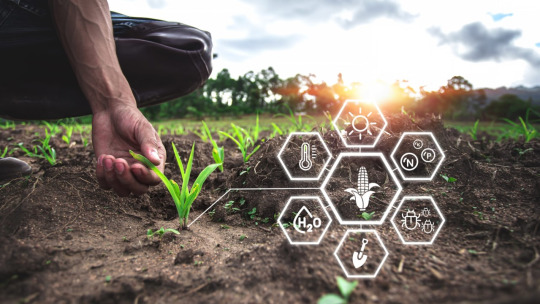
Introduction:
In recent years, the agricultural sector has undergone a profound digital transformation, propelled by the integration of Internet of Things (IoT) technology. This revolutionary shift has transcended traditional farming practices, empowering growers with real-time data and insights to make informed decisions, optimise resource utilisation, and maximise yields. By interconnecting physical devices and sensors with cloud computing and data analytics, IoT has ushered in a new era of precision agriculture, offering solutions to age-old challenges faced by farmers worldwide.
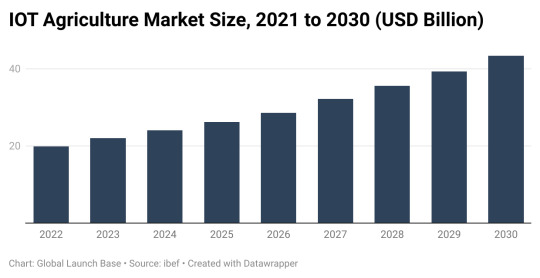
Figure: IOT Agriculture Market Size, 2021 to 2030 (USD Billion)
From the above figure we can see that IOT agriculture market size to surpass US$ 43.37 Bn by 2030
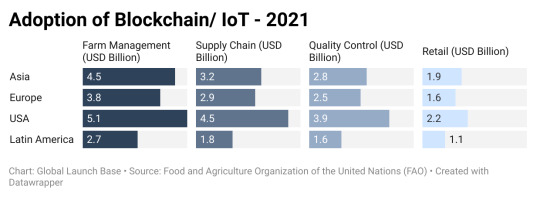
Figure: Adoption of Blockchain/ IoT - 2021
The marriage of IoT technology with agriculture has unlocked a plethora of opportunities across the entire farming ecosystem, from field management to supply chain logistics. This convergence has not only improved operational efficiency but also paved the way for sustainable farming practices. As the world grapples with escalating food demand, water scarcity, and environmental degradation, IoT-enabled solutions have emerged as indispensable tools in mitigating these challenges while ensuring food security and environmental stewardship.
Precision Farming:

Figure - Precision Farming
One of the cornerstone applications of IoT in agriculture is precision farming, which represents a paradigm shift from traditional blanket approaches to site-specific management. This innovative approach harnesses the power of IoT-enabled sensors, drones, and autonomous machinery to monitor and manage various aspects of crop production with unparalleled accuracy.
IoT sensors embedded in the soil continuously gather data on key parameters such as moisture levels, temperature, nutrient content, and pH levels. This real-time data is then transmitted to centralised platforms where it is analysed and processed using advanced algorithms. By leveraging this granular information, farmers can precisely tailor their irrigation, fertilisation, and pest control strategies to meet the specific needs of each crop and microenvironment within their fields.
Furthermore, the integration of IoT technology with precision agriculture has facilitated the development of variable rate application (VRA) systems. These systems utilise GPS-guided machinery to deliver inputs, such as water and nutrients, in precise quantities and locations based on the spatial variability detected in the field. By optimising input usage in this manner, farmers can not only enhance crop productivity and quality but also reduce costs and minimise environmental impact by avoiding over-application of inputs in areas where they are not needed.
Moreover, the data-driven insights generated through precision farming practices enable farmers to implement proactive measures to mitigate risks and optimise resource allocation. For instance, predictive analytics algorithms can forecast crop yields, pest outbreaks, and weather patterns, empowering farmers to make preemptive decisions to safeguard their crops and maximise profitability.
Overall, precision farming powered by IoT technology represents a quantum leap in agricultural productivity and sustainability. By harnessing the power of data-driven decision-making and precision management practices, farmers can unlock new levels of efficiency, profitability, and environmental stewardship in their operations. As IoT continues to evolve and become more accessible, the potential for innovation and transformation in agriculture is virtually limitless.
Smart Irrigation Systems:
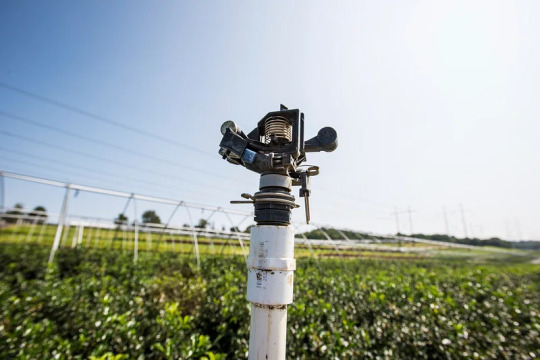
Figure: Smart Irrigation Systems
Water scarcity is a pressing concern for farmers worldwide, exacerbated by climate change and population growth. In response to this challenge, smart irrigation systems have emerged as a game-changing solution, leveraging IoT technology to optimize water usage in agricultural fields.
At the heart of smart irrigation systems are IoT-enabled sensors that continuously monitor soil moisture levels, weather conditions, and crop water requirements in real-time. These sensors transmit data wirelessly to a central control system, where advanced algorithms analyse the information and determine the precise amount and timing of irrigation needed for each area of the field.
By dynamically adjusting irrigation schedules based on actual field conditions, smart irrigation systems minimise water wastage while ensuring that crops receive the optimal amount of moisture for healthy growth. This targeted approach not only conserves water but also enhances crop yield and quality by avoiding both under- and over-irrigation, which can lead to stress, disease, and reduced productivity.
Furthermore, smart irrigation systems offer farmers unprecedented control and flexibility over their irrigation practices. Through mobile or web-based applications, farmers can remotely monitor and manage their irrigation systems from anywhere, allowing them to respond quickly to changing weather patterns or crop needs. Some advanced systems even integrate weather forecasts and soil moisture data to automatically adjust irrigation schedules, further streamlining water management and reducing manual intervention.
Beyond water conservation and crop productivity, smart irrigation systems also deliver significant economic and environmental benefits. By reducing water usage and energy consumption associated with pumping, farmers can lower their operational costs and mitigate their carbon footprint. Additionally, by minimising runoff and leaching of nutrients and agrochemicals into water bodies, smart irrigation systems help protect water quality and preserve fragile ecosystems.
Crop Monitoring and Management:
In the realm of modern agriculture, crop monitoring and management have been revolutionised by the integration of Internet of Things (IoT) technology. With the aid of IoT-enabled sensors, drones, and data analytics platforms, farmers now have unprecedented visibility into the health, growth, and condition of their crops, enabling them to make informed decisions and optimise production practices.
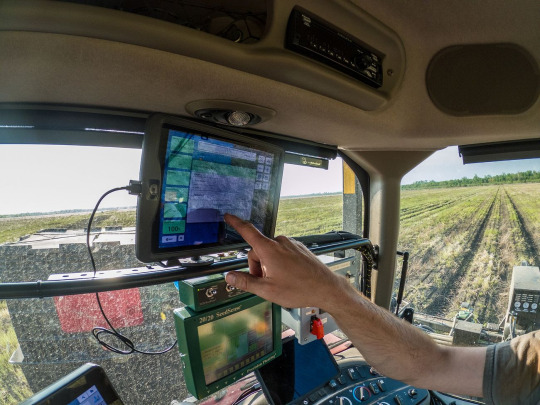
IoT sensors deployed in the field collect a wealth of data on various parameters such as soil moisture, temperature, humidity, nutrient levels, and crop health indicators. This data is transmitted in real-time to centralised platforms where it is processed and analysed using advanced algorithms. By harnessing the power of big data analytics and machine learning, farmers can derive actionable insights from this data, allowing them to monitor crop performance, detect anomalies, and identify potential issues before they escalate.
Drones equipped with high-resolution cameras and multispectral imaging sensors play a pivotal role in crop monitoring and management. These aerial platforms can capture detailed imagery of fields from above, providing farmers with valuable insights into crop health, growth patterns, and pest infestations. By analysing these images, farmers can pinpoint areas of stress or vegetation anomalies, enabling them to take targeted corrective actions such as adjusting irrigation or applying pest control measures.
Moreover, IoT technology enables the development of predictive analytics models that forecast crop yields, disease outbreaks, and pest infestations based on historical data and real-time observations. By leveraging these predictive insights, farmers can proactively plan their planting, harvesting, and pest management strategies to optimise yields and minimise losses.
Additionally, IoT-enabled crop monitoring systems offer farmers greater flexibility and scalability in their operations. These systems can be tailored to meet the specific needs of different crops, growing conditions, and farming practices, allowing farmers to optimise resources and maximise profitability. Furthermore, the integration of IoT with other emerging technologies such as artificial intelligence and robotics holds the promise of further enhancing crop monitoring and management capabilities, paving the way for more autonomous and efficient farming practices.
Overall, IoT technology has transformed crop monitoring and management from a labour-intensive and resource-intensive process into a data-driven and proactive endeavour. By providing farmers with real-time insights, predictive analytics, and actionable recommendations, IoT-enabled solutions empower farmers to optimise crop yields, reduce risks, and enhance sustainability in agriculture. As IoT continues to evolve and become more accessible, the potential for innovation and transformation in crop monitoring and management is virtually limitless.
Livestock Monitori
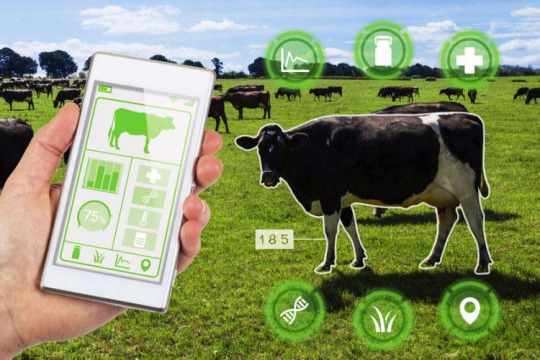
Figure: Livestock Monitoring
In the realm of modern agriculture, livestock monitoring has undergone a paradigm shift with the advent of Internet of Things (IoT) technology. Traditionally, livestock management relied heavily on manual observation and intuition, making it challenging for farmers to detect health issues, optimise feeding regimes, and maximise productivity. However, IoT-enabled sensors and data analytics platforms have revolutionised livestock monitoring, offering farmers unprecedented insights into the health, behaviour, and performance of their animals. IoT sensors, attached to animals or installed in their living environments, continuously collect data on key parameters such as body temperature, heart rate, activity levels, and rumination patterns. This real-time data is transmitted wirelessly to centralised platforms where it is analysed and processed using advanced algorithms. By monitoring these physiological and behavioural indicators, farmers can detect signs of illness, stress, or reproductive cycles early on, allowing them to intervene promptly and provide appropriate care.
Moreover, IoT technology enables farmers to track the location and movement of livestock, particularly in extensive grazing systems or large-scale operations. GPS-enabled tracking devices attached to animals provide real-time information on their whereabouts, allowing farmers to monitor grazing patterns, prevent livestock theft, and optimise pasture management. This enhanced visibility into animal behaviour and movement enables farmers to make data-driven decisions to improve herd health, productivity, and welfare.
Furthermore, IoT-enabled livestock monitoring systems offer farmers greater efficiency and scalability in their operations. These systems can be integrated with other farm management software, such as feed management or reproductive tracking systems, to provide a comprehensive view of herd performance and profitability. Additionally, the use of wearable devices and smart collars allows farmers to remotely monitor individual animals or entire herds from anywhere, reducing the need for manual labour and improving overall productivity.
In addition to improving animal health and welfare, IoT-enabled livestock monitoring systems also deliver significant economic and environmental benefits. By optimising feeding regimes and managing herd health more effectively, farmers can reduce feed wastage, minimise veterinary costs, and increase overall profitability. Moreover, by minimising the environmental impact of livestock production through more efficient resource utilisation and waste management, IoT technology contributes to the sustainability of agriculture.
Supply Chain Optimization:
In the dynamic landscape of agriculture, supply chain optimization has emerged as a critical area where Internet of Things (IoT) technology is driving significant transformation. From farm to fork, the agricultural supply chain encompasses a complex network of processes, stakeholders, and resources. IoT-enabled solutions offer unprecedented visibility, traceability, and efficiency across this entire ecosystem, revolutionising how agricultural products are produced, processed, and distributed.
At the farm level, IoT sensors deployed in fields and orchards collect data on environmental conditions, crop growth stages, and harvest readiness. This real-time data enables farmers to optimise planting schedules, manage inputs more efficiently, and anticipate yield fluctuations. By integrating IoT data with farm management systems, farmers can make data-driven decisions to maximise productivity while minimising costs and environmental impact.
As agricultural products move through the supply chain, IoT technology plays a crucial role in ensuring product quality, safety, and compliance. Temperature, humidity, and location sensors embedded in storage facilities, transportation vehicles, and processing plants monitor the conditions of perishable goods in real-time. Any deviations from optimal conditions trigger alerts, allowing stakeholders to take corrective action to prevent spoilage, contamination, or quality degradation. By maintaining the integrity of the cold chain and reducing food waste, IoT-enabled supply chain solutions contribute to improved food safety and sustainability.
Moreover, IoT technology enhances transparency and traceability throughout the agricultural supply chain, enabling stakeholders to track the journey of products from farm to consumer. Blockchain-based platforms leverage IoT data to create immutable records of product origin, production practices, and handling procedures. This transparency builds trust among consumers, enhances brand reputation, and facilitates compliance with regulatory requirements such as food safety standards and sustainability certifications.
Additionally, IoT-enabled supply chain solutions offer opportunities for optimization and cost savings through predictive analytics and automation. By analysing historical data and real-time insights, predictive analytics models can forecast demand, optimise inventory levels, and streamline logistics operations. Autonomous vehicles and robotic systems equipped with IoT sensors and artificial intelligence algorithms further enhance efficiency by automating tasks such as harvesting, sorting, and packaging.
Furthermore, IoT technology facilitates collaboration and coordination among supply chain partners through real-time data sharing and communication. Cloud-based platforms and mobile applications enable seamless integration and exchange of information between farmers, suppliers, distributors, and retailers. This collaboration fosters greater agility, responsiveness, and resilience in the face of supply chain disruptions such as weather events, market fluctuations, or global pandemics.
Advanced IoT Applications for Farms

1. Drone-based scouting and spraying: Imagine agile drones equipped with high-resolution cameras and multispectral sensors. These can autonomously map fields, identify weeds and pests with incredible accuracy, and deliver targeted treatment exactly where it's needed. This reduces reliance on broad-spectrum pesticides, promotes sustainable practices, and minimises environmental impact.
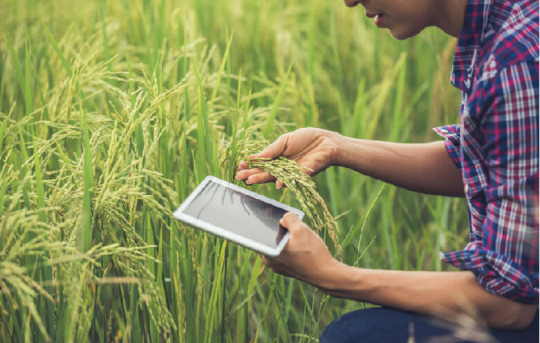
2. Predictive analytics for disease and pest control: IoT sensors combined with advanced AI can analyse historical data and weather patterns to predict outbreaks of diseases and pests. This allows farmers to take preventive measures, such as applying natural deterrents or introducing beneficial insects, before problems escalate.
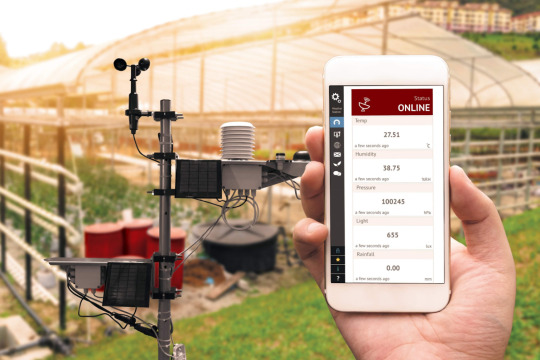
3. Climate-smart agriculture: IoT weather stations with advanced sensors can provide hyper-local weather data, including real-time wind speed, precipitation forecasts, and even data on micronutrient levels in the atmosphere. This empowers farmers to make informed decisions about planting schedules, crop selection, and irrigation strategies based on real-time forecasts, optimising yields and building resilience against climate variations.
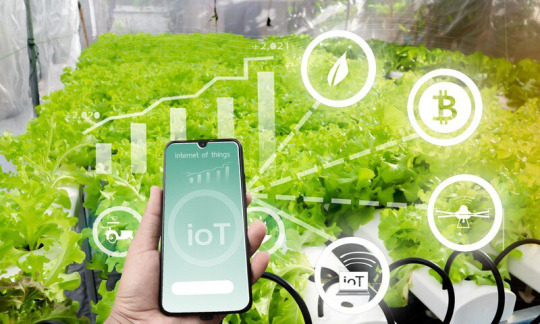
4. Blockchain for traceability and transparency: Imagine a system where every step of a product's journey, from farm to fork, is recorded on a secure blockchain ledger. Sensors embedded in packaging can monitor temperature and storage conditions during transportation, ensuring food safety. Consumers can then scan a QR code and access a transparent record of the product's origin, farming practices used, and even the environmental impact of its production.

5. Robotics for controlled-environment agriculture (CEA): In indoor farms and vertical farming facilities, IoT plays a central role. Robots equipped with sensors and grippers can perform delicate tasks like seeding, transplanting, and harvesting with minimal damage to crops. This not only reduces labour costs but also ensures consistent quality and higher yields in controlled environments.
Cultivating Innovation with IoT
The agricultural IoT revolution isn't just a theoretical concept – it's being driven by a wave of forward-thinking companies developing cutting-edge solutions. Here are a few industry leaders to watch:
Deere & Company: A major player in agricultural machinery, Deere offers a suite of IoT-powered solutions under the John Deere® FarmSight® banner. These include yield monitors, tractor telematics, and weather data analysis tools, empowering farmers to optimise their operations.
Trimble Inc.: This company provides a range of advanced positioning and data management solutions for agriculture. Their offerings include automated guidance systems for tractors and combines, allowing for high-precision planting and harvesting, and software platforms that integrate data from various sources to give farmers a comprehensive view of their operations.
SenseFly (Parrot Group): Specialises in agricultural drone technology. Their drones equipped with high-resolution cameras and multispectral sensors, are used for field scouting, identifying crop health issues, and creating detailed 3D field maps.
InFarm: A leader in the indoor vertical farming space, InFarm leverages IoT sensors and automation extensively. Their vertical farms are equipped with environmental control systems that optimise light, temperature, and humidity for specific crops, all monitored and managed through a central IoT platform.
Challenges and Future Outlook:
While the potential of IoT in agriculture is undeniable, there are challenges that need to be addressed for widespread adoption. Here's a look at some key hurdles and how we can work towards a future where smart farming flourishes:
Challenges:
Connectivity: Reliable internet access in rural areas is crucial for real-time data collection and analysis. Efforts are underway to expand broadband access and explore alternative low-power wide-area networks (LPWAN) for improved connectivity in remote locations.
Cost: The upfront investment in sensors, devices, and software can be significant, especially for small and medium-scale farms. Government subsidies, innovative financing models, and standardisation of technologies can help bring down costs and make these solutions more accessible.
Data Security and Privacy: As farms become increasingly reliant on data, robust cybersecurity measures are essential to protect sensitive information from breaches and ensure farmer trust.
Digital Literacy: Equipping farmers with the skills to understand and utilise IoT technologies effectively is crucial. Training programs, workshops, and user-friendly interfaces can bridge the digital divide and empower farmers to harness the full potential of these tools.
Future Outlook:
Despite these challenges, the future of IoT in agriculture is bright. As technology costs decrease, connectivity improves, and farmers become more comfortable with digital tools, adoption is expected to accelerate. Here are some exciting possibilities to look forward to:
Integration of AI and Machine Learning: Advanced analytics will extract even deeper insights from agricultural data, allowing for predictive maintenance of equipment, automated disease and pest control, and hyper-personalised crop management strategies.
Rise of Agtech Startups: A growing number of innovative startups are developing niche solutions tailored to specific agricultural needs. This will lead to a more diverse and dynamic ecosystem, offering farmers a wider range of choices.
Focus on Sustainability: IoT will play a key role in optimising water usage, minimising fertiliser application, and reducing the environmental impact of agriculture. This will contribute to a more sustainable food production system.
In conclusion, IoT holds immense potential to transform agriculture. By addressing the existing challenges and fostering collaboration between farmers, technology providers, and policymakers, we can usher in an era of smart farming that is not only productive but also sustainable and resource-efficient.
— x —
Global Launch Base helps international startups expand in India. Our services include market research, validation through surveys, developing a network, building partnerships, fundraising, and strategy revenue growth. Get in touch to learn more about us.
Contact Info:
Website: www.globallaunchbase.com
LinkedIn: https://www.linkedin.com/company/globallaunchbase/
Email: [email protected]
#AgriTechCEO hashtag#IoTAgricultureLeader hashtag#SmartFarmingPioneer#hashtag#PrecisionAgVisionary hashtag#DigitalAgChampion hashtag#FarmTechInnovator#IoTAgRevolutionary hashtag#AgriInnovationCEO hashtag#FutureFarmingExpert#AgriTechTrailblazer hashtag#SustainableAgLeader hashtag#DataDrivenAgCEO#AgriTechDisruptor hashtag#IoTAgSolutionist hashtag#FarmTechVisionary#AgriDigitalTransformationLeader hashtag#IoTAgriInnovator#AgriTechGameChanger hashtag#SmartAgPioneer hashtag#IOT hashtag#Agriculture
0 notes
Text
The Quantum Leap in Trading: Unlocking Success with Quantum AI Technology
In the world of trading, where every second and every decision counts, imagine having a tool that works like a time machine, giving you insights into market trends before they happen. This is not the stuff of science fiction; it's the reality of what Quantum AI technology is bringing to the trading world. Let's dive into how this groundbreaking technology is paving the way for a new era in trading.
Quantum AI: The Game Changer in Trading
Quantum AI is revolutionizing trading by bringing in computational power and analytics capabilities far beyond what traditional computers can achieve. It's like having the ultimate cheat sheet that forecasts market movements with astonishing accuracy.

How Does Quantum AI Work?
Quantum AI leverages the principles of quantum mechanics to process information at an exponential rate. Think of it as a supercharged brain, capable of analyzing vast amounts of data in the blink of an eye.
The Advantages of Quantum AI in Trading
Speed and Accuracy: Quantum AI's ability to process information rapidly and accurately gives traders a significant advantage in making swift, informed decisions.
Predictive Insights: By analyzing historical and real-time data, Quantum AI can predict market trends, helping traders to stay one step ahead.
Quantum AI Transforming Market Analysis
With Quantum AI, market analysis becomes more comprehensive and nuanced, enabling traders to understand market dynamics at a much deeper level, much like seeing the matrix behind the market moves.
The Impact of Quantum AI on Decision Making
Quantum AI empowers traders to make decisions based on data-driven insights, reducing the reliance on guesswork and intuition, and leading to more strategic and profitable outcomes.
Challenges and Solutions in Quantum Trading
While Quantum AI offers immense benefits, it also presents challenges such as high costs and technical complexities. However, as technology advances, these challenges are becoming more manageable, paving the way for wider adoption.
Quantum AI vs. Traditional Trading Systems
Unlike traditional trading systems that are linear and slower, Quantum AI operates in a multi-dimensional space, processing and analyzing data at speeds and depths that were previously unimaginable.
The Future of Trading with Quantum AI
The integration of Quantum AI in trading signifies a leap towards an era of hyper-efficient markets, where information is processed and acted upon in real-time, eliminating inefficiencies and opening up new opportunities for traders.
Ethical Considerations in Quantum Trading
As with any powerful technology, Quantum AI brings ethical considerations, especially in terms of market fairness and data privacy. It's imperative to establish guidelines that ensure its use promotes transparency and equity in trading.
Real-World Success Stories of Quantum AI
Companies and traders who have adopted Quantum AI are already seeing tangible benefits, with improved accuracy in market predictions and increased profitability, showcasing the practical value of this technology.
How to Get Started with Quantum AI
Getting started with Quantum AI in trading involves understanding the basics of quantum computing, familiarizing oneself with AI systems, and gradually integrating these technologies into existing trading practices.
Quantum AI in Day-to-Day Trading
For the average trader, Quantum AI can be a game-changer, providing tools and insights that were once the domain of large financial institutions, democratizing access to advanced trading technologies.
Global Influence of Quantum AI on Trading
Quantum AI is not just changing the trading landscape in one region but is having a global impact, with markets around the world beginning to leverage its potential to drive efficiency and profitability.
Conclusion: The New Era of Quantum Trading
Quantum AI is ushering in a new era in trading, characterized by unparalleled efficiency, accuracy, and profitability. As we stand on the brink of this quantum leap, the future of trading looks brighter and more exciting than ever, promising a world where success is not just a possibility but a probability powered by Quantum AI technology
0 notes
Text
Cloud-based Quantum Computing Market Segmented On The Basis Of Solution, Technology, Application, Vertical, Region And Forecast To 2030: Grand View Research Inc.
San Francisco, 28 March 2024: The Report Cloud-based Quantum Computing Market Size, Share & Trends Analysis Report By Solution (Software, Services), By Technology, By Application, By Verticals, By Region, And Segment Forecasts, 2024 – 2030
The global cloud-based quantum computing market size is anticipated to reach USD 2.21 billion by 2030 and is anticipated to expand at a CAGR of 20.5% during…

View On WordPress
0 notes
Text
Innovations & Growth Potential in the Global Thermometer Market
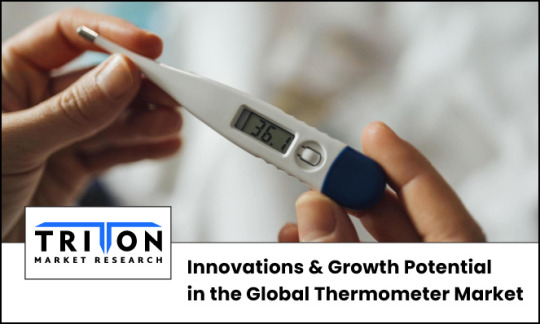
As human body temperature continues to be an early sign of diagnosis, thermometers are found in every clinic and household. Since the inception of medical sciences, thermometers have undergone several developments to bring more accuracy. Triton’s research states that the Global Thermometer Market is estimated to advance at a CAGR of 7.56% during the forecast period 2023-2030.
Due to the environmental toxicity of mercury, the Environment Protection Agency (EPA) recommends phasing out conventional mercury-based thermometers. Thus, infrared radiation (IR) thermometers, known for their speed and accuracy in offering near-instantaneous temperatures, are now widely used. In this regard, Telepower Communication Co Ltd introduced a cost-effective, high-performing infrared thermometer that supports Bluetooth connectivity. Such developments foster the need for more product innovations.
Innovations in Digital Thermometers:
Smart/Digital Thermometers
The temperature measurement process has been revolutionized with technological innovations. In this regard, traditional mercury thermometers are making a new path for smart and digital thermometers. These contactless, smart heat sensors have the utmost precision in temperature detection.
Smart thermometers are distinguished from the traditional ones with their easy-to-read display and speedy detection of temperature. According to a report by the National Institute of Health (NIH), smart thermometer readings are highly predictive of surveillance data for a respective region and season. The report also found that smart thermometers helped in improving predictions of influenza among the people in California.
Superconductor Thermometer
Researchers at the National Institute of Standards and Technology (NIST) invented a miniature thermometer in November 2020 with big potential applications. This thermometer is 2.5 by 1.15 millimeters in size and is embedded in another cryogenic microwave device to measure temperature when placed on a chip. Compared to conventional ones, the NIST’s superconducting thermometer is capable of measuring temperatures below 1 Kelvin in about 5 milliseconds.
Thus, being faster, smaller, and more convenient than conventional cryogenic thermometers, the new invention can be mass-produced for chip-scale devices. It can monitor the temperature of processor chips in superconductor-based quantum computers, which must stay cold to function efficiently.
Ultra-fine thermal sensor
Researchers in Japan have developed a micro-thin thermal sensor. This can be easily attached to the skin to monitor the health of infants. Embedded in a super-fine, thin film, with about ¼ the thickness of human hair, this thermometer measures temperatures between 25-30 degrees Celsius.
Additionally, the materials used to manufacture these thermal sensors are cheap and widely available which ensures a commercialized use of the device.
FeverPhone App
A team of researchers from Washington University developed an application to measure temperature by placing the smartphone on the forehead. Named FeverPhone, this app allows the touchscreen to gather data and predict temperature within 90 seconds. It analyses interactions between the heat generated by the phone’s battery and the touch of fingers, accurately estimating body temperature without any extra hardware.
Notably, during a test conducted in an emergency department, the application showed impressive results in detecting core body temperatures compared to traditional ones. This eliminates the need to carry separate thermometers and rely on a smartphone for temperature monitoring.
Thermometers Market: Growth Potential Beyond Health Sector
Increasing Utility in the Manufacturing Sector:
A dominant manufacturing sector and the spillover effects lay the foundation for the growth of the thermometer market. Moreover, as per Triton’s analysis, the Asia-Pacific thermometer market is expected to witness the fastest growth at a CAGR of 8.54% over the forecast period 2023-2030.
Among the ASEAN countries, Singapore, Indonesia, and Thailand are experiencing a robust transformation within the manufacturing sector. Singapore’s industrial manufacturing contributes to around 20% -25% of its annual GDP. Major industry players like HP, Infineon, and Micron look forward to establishing next-generation manufacturing facilities in Singapore to make it among the top five exporters of high-tech goods.
Rising Importance of Temperature Monitoring in the Food Industry:
According to the World Health Organization (WHO), unsafe food causes 420,000 deaths and 600 million cases of food-borne diseases across the world. Thus, ensuring quality standards throughout the food cycle is important for a seamless process, starting from production to consumption.
Verifying correct temperatures is required during several stages like boiling, thawing, freezing, etc. Consistent temperatures help eliminate harmful bacteria, which minimizes the risk of food poisoning. Probe thermometers are, therefore, critical in food processing facilities, commercial kitchens, or retail settings. It ultimately determines the food safety standards throughout the supply chain.
Critical use of Thermometers in Research Laboratories:
Temperature records are crucial while conducting deep research, experiments, and scientific investigations. It helps in deriving accurate, data-driven conclusions. Laboratories, research industries, scientists, and environmentalists are completely dependent on thermometers for authentic temperature readings. A slight inaccuracy or a false reading may cause a scientific experiment to fail. Thus, heat-measuring devices help to determine the stability of compounds, the rate of chemical reactions, and the extent of these reactions.
Evidently, the use of thermometers is not restricted to the medical sector. Along with the precision and reliability of products, temperature records play an important role in various other sectors like agriculture, climatology, industrial manufacturing, weather forecasting, and archaeology. This widens the growth potential of temperature-measuring devices, creating opportunities for contenders in the global thermometer market.
FAQs
Q.1) Do battery thermometers have mercury?
A small amount of mercury is present in the button cell of battery thermometers.
Q.2) How big is the thermometer market?
The global thermometer market generated a revenue of $1504.98 million in 2022 and is expected to achieve $2710.08 million in 2030.
#Thermometer Market#Thermometer#Lifesciences#Medical Devices#Consumables#triton market research#market research reports
0 notes
Text
The Evolution of Data Analytics: Trends Shaping the Future
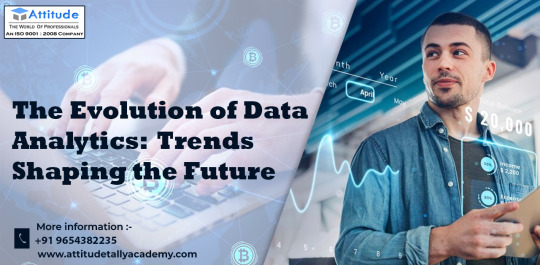
Introduction:
In the dynamic realm of modern business, data analytics stands as the beacon guiding strategic decisions and driving innovation. From its humble beginnings of basic data processing to the sophisticated real-time analytics of today, the evolution of data analytics reflects a journey marked by adaptation to technological breakthroughs, shifting consumer dynamics, and the evolving demands of industries. This article embarks on an exploration of this evolutionary path, uncovering the trends that are sculpting the future of data analytics.
Unveiling the Journey:
The roots of data analytics stretch back to the early stages of computing, where rudimentary techniques were employed to glean insights from structured data. However, the explosion of data volumes coupled with the quest for deeper insights soon rendered traditional methods obsolete. This catalyzed the emergence of more advanced data analytics techniques, setting the stage for a paradigm shift in how data is processed and utilized.
Embracing Transformational Trends:
Real-Time Analytics:
In today's hyper-connected world, the need for instantaneous insights has become paramount. Real-time analytics stands at the forefront of this demand, enabling businesses to process and analyze data as it flows in, facilitating immediate action and decision-making. Whether it's monitoring customer interactions, tracking market trends, or identifying anomalies, real-time analytics empowers organizations to navigate the dynamic landscape with agility and precision.
AI and Machine Learning:
The integration of Artificial Intelligence (AI) and Machine Learning (ML) has ushered in a new era of predictive and prescriptive analytics. These technologies empower organizations to uncover intricate patterns, forecast future trends, and optimize decision-making processes across diverse domains. From personalized recommendations in e-commerce to predictive maintenance in manufacturing, AI-driven analytics fuels efficiency and innovation, reshaping industries and redefining possibilities.
Data Democratization:
Gone are the days when data analytics was confined to the realms of data scientists and IT specialists. The democratization of data analytics has democratized access to data and analytical tools, empowering employees across departments to explore, visualize, and derive insights independently. This democratization fosters a culture of data-driven decision-making, amplifying organizational agility and innovation at all levels.
Edge Analytics:
As the Internet of Things (IoT) continues its exponential growth, edge analytics emerges as a pivotal trend. By processing data at the edge of the network, closer to the data source, organizations can unlock real-time insights while minimizing latency and conserving bandwidth. From optimizing operations in smart cities to enhancing safety in connected vehicles, edge analytics propels the efficiency and efficacy of IoT applications, driving transformative outcomes.
Looking Towards Tomorrow:
As we peer into the horizon of data analytics, the future appears brimming with promise, fueled by emerging technologies such as quantum computing, blockchain, and augmented analytics. Quantum computing holds the potential to revolutionize data processing capabilities, solving complex problems at unprecedented speeds. Blockchain technology ensures immutable and transparent data transactions, fortifying trust and security in analytics processes. Augmented analytics, empowered by AI, automates data preparation and insight generation, democratizing access to analytical capabilities and catalyzing innovation across industries.
Conclusion:
The evolution of data analytics trends is a testament to human ingenuity and technological prowess, reflecting our relentless pursuit of innovation in the quest for knowledge and efficiency. From its nascent stages to the precipice of a new era, data analytics continues to evolve, propelled by the convergence of AI, IoT, and emerging technologies. By embracing these trends and harnessing the power of data, organizations can chart a course towards success, navigating the complexities of the data-driven world with confidence and foresight.
Join us as we embark on this exhilarating journey through the ever-evolving landscape of data analytics, where every discovery brings us closer to unlocking the boundless potential of data-driven insights.
Suggested Blogs: -
Data visualization and statistical analysis tools
marketing analytics
data analytics best practices
0 notes
Text
The Future of Data Analytics: Trends to Watch in 2024

Imagine a world where every business decision, big or small, is backed by data-driven insights. That’s not just a distant future scenario; it’s the unfolding reality of 2024. Data analytics has evolved from a mere trend to a full-scale revolution, fundamentally changing how businesses strategize and operate. In this ever-expanding data universe, distilling vast amounts of information into actionable intelligence is invaluable.
Whether decoding customer preferences, streamlining operations, or tackling novel business challenges, data analytics serves as the guiding star through the complex terrain of today’s business world. Yet, the true power of data lies not just in its accumulation but in its innovative, strategic use.
KPI Digital as Your Strategic Partner
As we venture into 2024, it’s crucial to not only stay updated with the latest trends in data analytics but to master them. That’s where KPI Digital comes into play, bridging the gap between data and decision-making. Our expertise lies in transforming raw data into rich insights that drive business success.
Join us on this journey through the future of data analytics, where KPI Digital is your trusted digital analytics firm to unlock the potential of data to create opportunities and solutions tailored to your business needs.
A Closer Look at the Top 10 Data Analytics Trends of 2024
As we venture into 2024, data analytics is brimming with groundbreaking trends to influence how businesses harness data dramatically. From democratizing data access to embracing advanced AI technologies, these trends are pivotal for any forward-thinking business strategy. Let’s explore the top 10 data analytics trends that promise to shape the future of business intelligence and decision-making in 2024.
1. Data Democratization: Power to the People
Now, everyone in an organization can tap into data analysis thanks to user-friendly tools. This shift not only democratizes data access but also fosters a more data-informed culture across all levels of a business, enhancing decision-making and creativity organization-wide.
2. Generative AI: The New Creative Force
Generative AI is reshaping content creation with surprisingly human-like results, transcending traditional data roles to amplify creative processes and inspire innovative data use and content generation approaches. Its ability to generate new ideas and patterns can revolutionize industries from marketing to product development.
3. Augmented Analytics: AI Meets Human Insight
Merging AI’s computational abilities with human insights accelerates and simplifies data analysis, making complex data more understandable and actionable for decision-makers. This trend empowers businesses to extract deeper insights and forecast trends more accurately.
4. Natural Language Processing (NLP): Breaking Down Communication Barriers
NLP is evolving to facilitate more intuitive interactions between humans and machines. This advancement enhances how businesses engage with customers and process large volumes of conversational data for deeper insights, making complex data more accessible and interpretable.
5. Embedded Analytics: Insights at Your Fingertips
By integrating analytics into commonly used software, data becomes instantly accessible, streamlining decision-making processes and embedding data-driven insights into everyday work. This seamless integration ensures that actionable insights are readily available, enhancing efficiency and responsiveness.
6. Edge Computing: Real-Time Insights, Right Where You Need Them
Edge computing brings data processing closer to data sources, enabling faster, more efficient analysis. This approach is especially critical for businesses operating in real-time environments or dealing with large data streams, reducing latency and improving operational efficiency.
7. Quantum Computing: The Next Leap in Data Processing
Quantum computing is set to unlock new possibilities in data analytics by solving complex problems much faster than traditional computers, potentially revolutionizing various sectors, from finance to healthcare. Its advanced capabilities could lead to groundbreaking discoveries and solutions in cryptography and complex system modelling.
8. Continuous Intelligence: Keeping Pace with Change
Emphasizing real-time data analysis, this trend enables businesses to make more agile, informed decisions, keeping them aligned with fast-evolving market dynamics and customer preferences. Continuous intelligence facilitates a proactive approach to business management, enabling real-time responses to emerging trends and challenges.
8. Data for Social Good: Making a Difference with Insights
This trend sees data as a force for positive social change, addressing critical global issues through intelligent data analysis and informed decision-making. By harnessing data for social good, businesses can contribute to sustainable development goals and foster a more responsible corporate image.
9. Data Security and Privacy: The Non-Negotiables
As data’s role in business grows, so does the need for robust security and privacy measures. Protecting data isn’t just about compliance; it’s crucial to maintaining customer trust and safeguarding business integrity. In 2024, data security and privacy will be central to building resilient digital infrastructures and maintaining competitive advantage.
These trends signify a dynamic shift in the landscape of data analytics, promising innovative ways to leverage data for strategic advantages in 2024 and beyond.
Maximizing the Impact of Data Analytics: Strategies for Implementation in 2024
After exploring the top 10 data analytics trends for 2024, it’s crucial to consider how businesses can effectively implement these trends to maximize their impact. This section will delve into practical strategies that organizations can adopt to leverage these emerging trends in data analytics.
From integrating advanced AI technologies to ensuring robust data security, we’ll provide actionable insights for businesses to harness the full potential of data analytics in the coming year.
Partner with KPI Digital: Turn Data Analytics Trends into Your Business Advantage
As we wrap up our exploration of the top data analytics trends for 2024, it’s clear that the future of business intelligence is vibrant and dynamic. These trends are not just predictions but opportunities for businesses to innovate, grow, and stay ahead in an increasingly data-driven world. However, understanding these trends is just the first step. The real game-changer is how effectively you implement them into your business strategy.
The journey from data to insight to action is complex and requires a nuanced understanding of both technology and business.
That’s where KPI Digital comes in. With our expertise in cutting-edge data analytics, we can help you navigate this landscape, turning trends into tailored strategies that drive your business forward. Whether leveraging AI for deeper insights or ensuring your data practices are secure and efficient, our team is dedicated to empowering your business with the right data analytics tools and insights.
Take the Leap with KPI Digital: Your Guide in the Data-Driven Future
Don’t let these trends be just a part of your reading list. Make them a cornerstone of your business strategy in 2024. With KPI Digital by your side, you have a partner who understands the intricacies of data analytics and how to harness its power for your business needs.
Reach out to us, and let’s start a conversation about how we can turn these data analytics trends into a competitive advantage for your business. With KPI Digital, the future isn’t just something to prepare for—it’s something you can shape.
Contact us today, and let’s transform these insights into impactful actions for your business.
Reference URL: https://biographworld.com/the-future-of-data-analytics-trends-to-watch-in-2024/
0 notes
Text
Superconductor Market| Market Size, Analysis, Growth and Forecast, 2023 – 2027
Originally published on Technavio: Superconductor Market by Type, Product, and Geography - Forecast and Analysis 2023-2027
The Superconductor Market is currently undergoing comprehensive research and analysis, focusing on different types, products, and geographical dynamics, with a forecast spanning from 2023 to 2027. This research aims to provide valuable insights into the factors driving market growth and shaping the adoption of superconductors across different regions.
An important aspect of this analysis involves examining the various types of superconductors available in the market. These may include high-temperature superconductors (HTS) and low-temperature superconductors (LTS), each offering unique properties and applications. Understanding the characteristics and capabilities of each type of superconductor is crucial for predicting market trends and identifying growth opportunities within specific industries.
Furthermore, the study delves into the different products enabled by superconductors. These products span a wide range of applications, including magnetic resonance imaging (MRI) machines, particle accelerators, magnetic levitation (Maglev) trains, power transmission cables, and quantum computing devices, among others. The forecast evaluates adoption trends of these products, providing insights into the factors influencing market demand and growth trajectories.
Geographically, the analysis covers key regions including North America, Europe, Asia-Pacific, Latin America, and the Middle East and Africa. Each region presents unique opportunities and challenges for the superconductor market, influenced by factors such as technological infrastructure, industrialization, government initiatives, and research and development activities. The forecast examines regional trends in market size, growth prospects, and competitive landscape, offering valuable insights for stakeholders seeking to expand their presence in specific geographic markets.
The superconductor market is driven by factors such as the increasing demand for energy-efficient technologies, advancements in superconductor materials and manufacturing processes, and the growing adoption of superconductors in various critical applications. Additionally, the rise of renewable energy sources and the need for efficient power transmission and distribution systems contribute to market growth. The analysis explores how these factors shape market dynamics and drive adoption of superconductors across industries.
To Learn deeper into this report , View Sample PDF
In conclusion, the superconductor market analysis for the period 2023-2027 provides a comprehensive overview of types, products, and geographical dynamics. By understanding the factors influencing market trends and growth opportunities, stakeholders can make informed decisions to capitalize on emerging opportunities and drive innovation in the competitive landscape of superconductors.
For more information please contact.
0 notes
Text
Next-Generation Computing Market: Global Demand Analysis & Opportunity Outlook 2036
Research Nester Analytics LLC ’s recent market research analysis on “Next-Generation Computing Market: Global Demand Analysis & Opportunity Outlook 2036” delivers a detailed competitor’s analysis and a detailed overview of the global next generation computing market in terms of segmentation by component, type, deployment, organization size, end-use industry, and by region
Request Free Sample Copy of this Report @
Increasing Implementation of Artificial Intelligence and Machine Learning to Drive Growth of the Global Next-Generation Computing Market
The newest tech innovation, the Internet of Things, generates enormous amounts of data from networked devices such as home automation systems, GPS beacons, and virtual entertainment. The large volumes of data generated by these channels are increasingly being managed and stored through the use of next-generation computing. It generates a lot of sensitive data and stimulates interest in computing that is next generation. It entails monitoring temperatures, preparing for hardware failures, and turning on autonomous driving. There will be roughly 15.14 billion IoT devices by 2023. For instance, for the past seven years, the U.S. Department of Energy's (DOE) Exascale Computing Project (ECP) has brought together a diverse team of computing professionals to improve next-generation computer architectures and revolutionize scientific modelling. One of the distinguishing features of ECP is its cooperation with industry partners that have advanced exascale research and development and successfully combined hardware, software, and applications to establish a fully functional exascale ecosystem.
Some of the major growth factors and challenges that are associated with the growth of the global next-generation computing market are:
Growth Drivers:
Surging Adoption of Cloud-Based Computing Solutions
Development of Artificial Intelligence's Integration in Diverse Industries
Challenges:
Implementing computer technology can be costly, especially for small and medium-sized businesses. Costs associated with implementation substantially impede adoption and limit market expansion. Lack of qualified personnel capable of managing and implementing next-generation computing technology is upending the market. Growth will likely be limited as companies find it difficult to hire the right people to support their technological expenditures. Next-generation computer technology is handling large and sophisticated amounts of data, which is increasing security concerns and increasing the likelihood of security breakdowns and cyberattacks. This component carries the risk of causing data loss, theft, and compromise in addition to having a significant impact on the adoption of different technologies. The high cost of computing technologyis expected to hamper the market growth.
The global next-generation computing market is segmented component, type, deployment, organization size, and end-use industry, where type is sub-segmented into high-performance computing, quantum computing, cloud computing and edge computing. By the end of 2036, the cloud computing segment is anticipated to garner the largest revenue of USD 4087.66 billion with a CAGR of 19.54% over the forecast period. The primary drivers of the cloud computing industry are the increasing acceptance of remote work and the need for cloud-based business continuity solutions and services.
Over the forecast period of 2024-2036, the Asia Pacific next-generation computing market is predicted to develop at a CAGR of 20.74%. The Asia Pacific market was worth USD 89.96 billion in 2023, and it is expected to be worth USD 1004.26 billion by the end of 2036. The next-generation computing market in Asia-Pacific makes use of cutting-edge technology in the area, such as cloud computing, quantum computing, artificial intelligence, and machine learning. The market for next-generation computers is anticipated to expand as a result of the growing use of digital technology across a range of sectors, including manufacturing, banking, and healthcare. The market is anticipated to be driven by factors including the growing usage of IoT devices, the requirement for dependable and efficient computing infrastructure, and the growing need for big data analytics. The Asia-Pacific consumer IoT market was estimated to be worth 14.29 billion US dollars in 2022.
Access our detailed report at@
0 notes
Text
ALD Equipment Market Emerges as a Global Growth Driver with Projected USD 6.2 Billion Valuation by 2028
In the realm of cutting-edge semiconductor manufacturing, Atomic Layer Deposition (ALD) equipment takes center stage, charting a trajectory of unprecedented growth and technological advancement. The release of the "ALD Equipment Market Size, Share, Statistics, and Industry Growth Analysis Report" illuminates the market's significant role in shaping the semiconductor landscape, poised to reach a projected valuation of USD 6.2 billion by 2028.
The ALD equipment market is estimated to be worth USD 3.9 billion in 2023 and is projected to reach USD 6.2 billion by 2028, at a CAGR of 10.0% during the forecast period.
Download PDF Brochure:
Innovating Semiconductor Fabrication: ALD technology, with its precision in depositing thin films at an atomic level, stands as a linchpin in semiconductor fabrication. This press release encapsulates the key insights and growth drivers defining the ALD Equipment market's journey to becoming a global growth driver.
Key Growth Catalysts:
Advancements in Nanotechnology: ALD plays a pivotal role in the fabrication of nanoscale structures, aligning seamlessly with the industry's pursuit of advancements in nanotechnology.
Increased Semiconductor Demand: The surge in demand for advanced semiconductors, driven by emerging technologies like 5G, artificial intelligence, and Internet of Things (IoT), underscores the indispensability of ALD equipment in semiconductor manufacturing.
Energy Efficiency Focus: ALD's ability to enhance energy efficiency in devices, coupled with its contribution to the development of power-efficient electronic components, positions it as a cornerstone in the industry's sustainability endeavors.
Market Trajectory and Projections: The ALD Equipment market, as elucidated by the analysis report, demonstrates a robust growth trajectory. From its current standing, the market is poised to witness substantial expansion, with a projected valuation of USD 6.2 billion by 2028.
Anticipated Future Trends:
Application Diversity: ALD is expected to witness increased adoption across diverse applications, ranging from semiconductors and electronics to energy storage and medical devices.
Integration in Emerging Technologies: The market is anticipated to play a pivotal role in the integration of ALD technology into emerging technologies, including quantum computing and advanced sensors.
Shaping the Semiconductor Landscape: As we navigate the complexities of the modern technological landscape, the ALD Equipment market emerges as a key player, influencing the very fabric of semiconductor manufacturing. This press release invites industry stakeholders, investors, and technology enthusiasts to delve into the transformative potential of ALD equipment, an innovation poised to redefine the future of semiconductor fabrication on a global scale.
0 notes
Text
Quantum Computing Software Market Overview By Component, Deployment, Technology, Application, End-Use, Region And Forecast To 2030 : Grand View Research Inc.
San Francisco, 22 March 2024: The Report Quantum Computing Software Market Size, Share & Trends Analysis Report By Component, By Deployment, By Technology, By Application, By End-use, By Region, And Segment Forecasts, 2024 – 2030
The global quantum computing software market size is anticipated to reach USD 2.51 billion by 2030 and is anticipated to expand at a CAGR of 18.5% from 2024 to 2030,…

View On WordPress
0 notes
Text
Gaseous and Liquid Helium Market is Estimated to Witness Strong Growth Owing to Increasing Demand from Various Industries

The global gaseous and liquid helium market serves various end-use industries including healthcare, electronics, aerospace, nuclear energy, research and others. Gaseous and liquid helium finds wide applications in various diagnostic and therapeutic procedures in healthcare sector. It is used in NMR spectroscopy and MRI machines to produce strong magnetic fields essential for quality medical imaging. In electronics industry, helium is used for purging, pressurizing and cooling during manufacturing of semiconductors. The aerospace industry utilizes helium for various applications such as pressurizing fuel tanks, purging liquid propellant lines and as the lifting gas in airships and balloons. Rising demand from these industries is expected to drive growth of the market over the forecast period.
The global gaseous and liquid helium market is estimated to be valued at US$ 7.05 Bn in 2023 and is expected to exhibit a CAGR of 6.3% over the forecast period 2023 to 2030, as highlighted in a new report published by Coherent Market Insights.
Market Dynamics:
Increasing demand from various industries is one of the major drivers fueling growth of the gaseous and liquid helium market. Helium finds wide range of applications across healthcare, electronics, aerospace and other industries. Growth in these end-use industries is directly influencing demand for helium over the forecast period. Additionally, helium is a non-renewable resource with limited reserves primarily located in the United States, Qatar and Algeria. Rising consumption coupled with finite supply is projected to drive its prices upward over the coming years.
SWOT Analysis
Strength: Helium is used extensively in applications such as MRI scanners, semiconductors manufacturing and airships where replacement is difficult. It provides operational advantages such as lower temperature and inert properties. The market has limited domestic producers and long term contractual agreements ensure supply stability.
Weakness: Helium is a finite and non-renewable natural resource. Nearly all reserves are located in the United States, Qatar, and Algeria. Exploration and production activities are capital intensive with long lead times. Recycling rates are low due to its light molecular weight.
Opportunity: Growing healthcare infrastructure in developing nations increases demand for medical-grade helium for MRI and CT scanners. The development of fusion power reactors will require huge volumes of helium for cooling over sustained high temperatures. Emerging technologies such as quantum computing offer new avenues.
Threats: Geopolitical tensions could disrupt supply chains if major reserves come under government control of unstable regions. recycling rates remain low threatening future supplies. Technological advances may find substitutes for niche applications currently reliant on helium.
Key Takeaways
The global Gaseous and Liquid Helium market size is expected to witness high growth over the forecast period. The global gaseous and liquid helium market is estimated to be valued at US$ 7.05 Bn in 2023 and is expected to exhibit a CAGR of 6.3% over the forecast period 2023 to 2030.
Regional analysis: North America dominates currently due to the presence of major reserves in the United States. Asia Pacific is expected to grow at the fastest pace owing to increased investment in healthcare and industrial infrastructure. China, Japan, and India are among the key consumers.
Key players: Key players operating in the Gaseous and Liquid Helium market are ThermoFisher Scientific, Linde, Air Liquid, Messer Group, Matheson Tri-Gas, and Air Products. ThermoFisher Scientific leads with a significant market share supported by its medical-grade purification capabilities and global supply chain.
Get more insights on this topic:https://www.newswirestats.com/gaseous-and-liquid-helium-market-size-and-outlook/
#Gaseous and Liquid Helium#Gaseous and Liquid Helium Market#Gaseous and Liquid Helium Market size#Gaseous and Liquid Helium Market share#Coherent Market Insights
0 notes